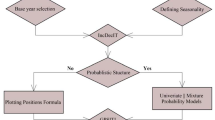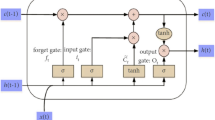Abstract
In this work, anthropogenic and natural factors were used to evaluate and forecast climate change on a global scale by using a variety of machine-learning techniques. First, significance analysis using the Shapley method was conducted to compare the importance of each variable. Accordingly, it was determined that the equivalent CO2 concentration in the atmosphere was the most important variable, which was proposed as further evidence of climate change due to fossil fuel-based energy generation. Following that, a variety of machine learning approaches were utilized to simulate and forecast the temperature anomaly until 2100 based on six distinct scenarios. Compared to the preindustrial period, the temperature anomaly for the best-case scenario was found to increase a mean value of 1.23 °C and 1.11 °C for the mid and end of the century respectively. On the other hand, the anomaly was estimated for the worst-case scenario to reach to a mean value of 2.52 °C and 4.97 °C for the same periods. It was then concluded that machine learning approaches can assist researchers in predicting climate change and developing policies for national governments, such as committing firmly to renewable energy regulations.











Similar content being viewed by others
Data availability
The datasets generated during and/or analysed during the current study are available from the corresponding author on reasonable request.
References
Mann ME, Zhang Z, Rutherford S, Bradley RS, Hughes MK, Shindell D, Ammann C, Faluvegi G, Ni F (2009) Global signatures and dynamical origins of the little ice age and medieval climate anomaly. Science 326(5957):1256–1260
Botkin DB, Keller EA (2011) Environmental science: earth as a living planet, 8th edn. Wiley, United States of America
Paasche Ø, Bakke J (2010) Defining the little ice age. Clim Past 6:2159–2175
Ritchie H, Roser M (2020) Energy, <https://ourworldindata.org/energy>; [Accessed 17 August 2021] 2020
Sarhadi A, Burn DH, Yang G, Ghodsi A (2016) Advances in projection of climate change impacts using supervised nonlinear dimensionality reduction techniques. Clim Dyn 48(3–4):1329–1351
Shine KP, Forster PMdF (1999) The effect of human activity on radiative forcing of climate change: a review of recent developments. Glob Planet Change 20(4):205–225
NCDC (2021) Anomalies vs. Temperature, <https://www.ncdc.noaa.gov/monitoring-references/dyk/anomalies-vs-temperature >; [Accessed 23 November 2021]
IPCC (2007) Climate change 2007: Synthesis report, in: R.K. Pachauri, A. Reisinger (Eds.) Geneva, Switzerland
Günay ME (2016) Forecasting annual gross electricity demand by artificial neural networks using predicted values of socio-economic indicators and climatic conditions: case of Turkey. Energy Policy 90:92–101
Sen D, Günay ME, Tunç KMM (2019) Forecasting annual natural gas consumption using socio-economic indicators for making future policies. Energy 173:1106–1118
Sen D, Tunç KMM, Günay ME (2021) Forecasting electricity consumption of OECD countries: a global machine learning modeling approach. Utilities Policy 70:101222
Feldhoff JH, Lange S, Volkholz J, Donges JF, Kurths J, Gerstengarbe F-W (2014) Complex networks for climate model evaluation with application to statistical versus dynamical modeling of South American climate. Clim Dyn 44(5–6):1567–1581
Huntingford C, Jeffers ES, Bonsall MB, Christensen HM, Lees T, Yang H (2019) Machine learning and artificial intelligence to aid climate change research and preparedness. Environ Res Lett 14(12):124007
Li W, Gao X, Hao Z, Sun R (2021) Using deep learning for precipitation forecasting based on spatio-temporal information: a case study, Clim Dynam
Taki M, Rohani A, Yildizhan H (2021) Application of machine learning for solar radiation modeling. Theoret Appl Climatol 143(3–4):1599–1613
Zhong-Ming LU (2022) Data-driven integrated assessment of global wild-caught seafood exported to Hong Kong by 2030 in different representative concentration and shared socioeconomic pathways. Adv Clim Change Res
Abbot J, Marohasy J (2017) The application of machine learning for evaluating anthropogenic versus natural climate change. GeoResJ 14:36–46
Mansfield LA, Nowack PJ, Kasoar M, Everitt RG, Collins WJ, A. (2020) Voulgarakis, Predicting global patterns of long-term climate change from short-term simulations using machine learning, npj climate and Atmospheric. Science 3:44
Zheng H (2018) Analysis of global warming using machine learning, computational water, energy, and environmental. Engineering 07(03):127–141
Kalra S, Lamba R, Sharma M (2020) Machine learning based analysis for relation between global temperature and concentrations of greenhouse gases. J Inf Optim Sci 41(1):73–84
ourworldindata, Population, <https://ourworldindata.org/grapher/population>; [Accessed 14 September 2021], 2021.
EEA, Atmospheric Greenhouse Gas Concentrations, <https://www.eea.europa.eu/data-and-maps/indicators/atmospheric-greenhouse-gas-concentrations-7>; [Accessed 14 September 2021], (2021).
Silso, Yearly mean total sunspot number, <https://wwwbis.sidc.be/silso/infosnytot>; [Accessed 14 September 2021], (2021).
LASP, Historical Total Solar Irradiance Reconstruction Time Series, <https://lasp.colorado.edu/lisird/data/historical_tsi/>; [Accessed 14 September 2021], (2021).
ourworldindata, Average Temperature Anomaly Global, <https://ourworldindata.org/grapher/temperature-anomaly?country=~Global>; [accessed 14 September 2021], (2021).
Hinkle DE, Wiersma W, Jurs SG (2003) Applied statistics for the behavioral sciences, 5th edn. Houghton Mifflin Harcourt, Boston
Larose DT, LCD (2014) Discovering knowledge in data: an introduction to data mining, 2 ed., John Wiley & Sons, New Jersey
Suvarna M, Jahirul MI, Aaron-Yeap WH, Augustine CV, Umesh A, Rasul MG, Günay ME, Yildirim R, Janaun J (2022) Predicting biodiesel properties and its optimal fatty acid profile via explainable machine learning. Renew Energy 189:245–258
Cohen S, Ruppin E, Dror G (2005) Feature selection based on the shapley value, proceedings of the nineteenth international joint conference on artificial intelligence, Edinburgh, Scotland, UK
Hochreiter S, Schmidhuber J (1997) Long short-term memory. Neural Comput 9(8):1735–1780
Yu Y, Si X, Hu C, Zhang J (2019) A review of recurrent neural networks: LSTM cells and network architectures. Neural Comput 31(7):1235–1270
Bilgili M, Yildirim A, Ozbek A, Celebi K, Ekinci F (2020) Long short-term memory (LSTM) neural network and adaptive neuro-fuzzy inference system (ANFIS) approach in modeling renewable electricity generation forecasting. Int J Green Energy 18(6):578–594
Memarzadeh G, Keynia F (2020) A new short-term wind speed forecasting method based on fine-tuned LSTM neural network and optimal input sets. Energy Convers Manag 213:112824
Chen Z-T, Liu H-Y, Xu C-Y, Wu X-C, Liang B-Y, Cao J, Chen D (2022) Deep learning projects future warming-induced vegetation growth changes under SSP scenarios. Adv Clim Chang Res 13(2):251–257
Gao B, Huang X, Shi J, Tai Y, Zhang J (2020) Hourly forecasting of solar irradiance based on CEEMDAN and multi-strategy CNN-LSTM neural networks. Renew Energy 162:1665–1683
Pedregosa F, Varoquaux G, Gramfort A, Michel V, Thirion B, Grisel O, Blondel M, Prettenhofer P, Weiss R, Dubourg V, Vanderplas J, Passos A, Cournapeau D, Brucher M, Perrot M, Duchesnay É (2011) Scikit-learn: machine learning in Python. J Mach Learn Res 12:2825–2830
Chen T, Guestrin (2016) XGBoost, Proceedings of the 22nd ACM SIGKDD International Conference on Knowledge Discovery and Data Mining, pp. 785–794.
Chen T, Guestrin C (2016) XGBoost: A scalable tree boosting system, Proceedings of the 22nd ACM SIGKDD International Conference on Knowledge Discovery and Data Mining, Association for Computing Machinery, San Francisco, pp. 785–794.
xgboost, XGBoost Parameters, <https://xgboost.readthedocs.io/en/latest/parameter.html>; [accessed 11 November 2021], 2021.
Dangeti P (2017) Statistics for machine learning. Packt Publishing, Birmingham
Liaw A, W. M. (2002) Classification and regression by random. Forest, R News 2(3) 18–22
Segal MR (2004) Machine learning benchmarks and random forest regression, UCSF: Center for bioinformatics and molecular biostatistics https://escholarship.org/uc/item/35x3v9t4
Fathi E, Shoja BM (2018) Deep neural networks for natural language processing, in: V.N. Gudivada, C.R. Rao (Eds.), Handbook of Statistics, Elsevier2018, pp. 229–316.
Larose DT, Larose CD (2014) Discovering knowledge in data: an introduction to data mining, 2nd edn. John Wiley & Sons, New Jersey
Abdel-Rahman HI, Marzouk BA (2019) Statistical method to predict the sunspots number. NRIAG J Astron Geophys 7(2):175–179
van Vuuren DP, den Elzen MGJ, Lucas PL, Eickhout B, Strengers BJ, van Ruijven B, Wonink S, van Houdt R (2007) Stabilizing greenhouse gas concentrations at low levels: an assessment of reduction strategies and costs. Clim Change 81(2):119–159
Wise M, Calvin K, Thomson A, Clarke L, Bond-Lamberty B, Sands R, Smith SJ, Janetos A, Edmonds J (2009) Implications of limiting CO2 concentrations for land use and energy. Science 324(5931):1183–1186
Hijioka Y, Matsuoka Y, Nishimoto H, Masui T, Kainuma M (2008) Global GHG emission scenarios under GHG concentration stabilization targets. J Glob Environ Eng 13:97–108
Riahi K, Grübler A, Nakicenovic N (2007) Scenarios of long-term socio-economic and environmental development under climate stabilization. Technol Forecast Soc Chang 74(7):887–935
Schurer AP, Mann ME, Hawkins E, Tett SFB, Hegerl GC (2017) Importance of the pre-industrial baseline in determining the likelihood of exceeding the paris limits. Nat Clim Chang 7(8):563–567
UNFCCC, What is the Kyoto Protocol?, <https://unfccc.int/kyoto_protocol>; [Accessed 11 November 2021], 2021.
UNFCCC, The Paris Agreement, <https://unfccc.int/process-and-meetings/the-paris-agreement/the-paris-agreement>; [Accessed 11 November 2021], 2021.
Author information
Authors and Affiliations
Corresponding author
Ethics declarations
Conflict of interest
All authors certify that they have no affiliations with or involvement in any organization or entity with any financial interest or non-financial interest in the subject matter or materials discussed in this manuscript.
Additional information
Publisher's Note
Springer Nature remains neutral with regard to jurisdictional claims in published maps and institutional affiliations.
Rights and permissions
Springer Nature or its licensor (e.g. a society or other partner) holds exclusive rights to this article under a publishing agreement with the author(s) or other rightsholder(s); author self-archiving of the accepted manuscript version of this article is solely governed by the terms of such publishing agreement and applicable law.
About this article
Cite this article
Sen, D., Huseyinoglu, M.F. & Günay, M.E. Prediction of global temperature anomaly by machine learning based techniques. Neural Comput & Applic 35, 15601–15614 (2023). https://doi.org/10.1007/s00521-023-08580-3
Received:
Accepted:
Published:
Issue Date:
DOI: https://doi.org/10.1007/s00521-023-08580-3




